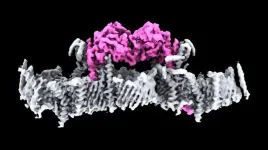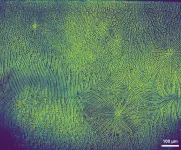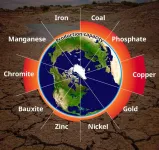(Press-News.org) For cancers of organs like the liver, the long-term impact of our diet has been well studied — so much so that we have guidance about red meat, wine and other delicacies.
A new study from researchers at University of Florida Health looks at another kind of organ whose cancer risk may be affected by poor diet: the lungs. The study was funded by several National Institutes of Health grants and a collaboration between the University of Kentucky's Markey Cancer Center and the UF Health Cancer Center.
“Lung cancer has not traditionally been thought of as a dietary-related disease,” said Ramon Sun, Ph.D., an associate professor and director of the UF Center for Advanced Spatial Biomolecule Research. “Diseases like pancreatic cancer or liver cancer, yes. However, when it comes to lung cancer, the idea that diet could play a role is rarely discussed.”
To the team’s knowledge, this is the first study of the association between lung cancer and poor diet at an NCI-designated cancer center, said study collaborator Matthew Gentry, Ph.D., a professor and chair of biochemistry and molecular biology at the UF College of Medicine.
The team used a high-content spatial metabolomics platform Sun created in 2020.
“This platform offered a new lens through which to visualize diseases, enabling researchers to discern previously undiscovered molecular patterns and interactions with striking detail and depth of insight,” Sun said.
In the case of lung adenocarcinoma, the cancer that accounts for 40% of lung cancer diagnoses worldwide, the work built off Gentry and Sun’s 20-year study of an ultra-rare condition called Lafora disease.
The neurological disorder has a devastating trajectory. Patients develop seemingly normally for a decade, then present with epilepsy. Dementia ensues, and most patients die before they turn 25 years old.
The new study borrows from how Lafora unfolds, focusing on glycogen accumulation. This storage molecule, made up of glucose, or a simple sugar, has been found to accumulate in high levels across a variety of cancers and other diseases.
Through lab models and computer-guided models of glycogen stores in the lung, the researchers showed that in lung cancer, glycogen acts as an oncogenic metabolite, akin to a “giant lollipop for cancer’s sweet tooth.”
The more glycogen in the cancer cells, the bigger and worse the tumor growth. When scientists fed mice a high-fat, high-fructose “Western diet” that supported more glycogen in the blood, lung tumors grew. When glycogen levels decreased, tumor growth did, too.
In short: The typical Western diet increases glycogen levels and glycogen feeds lung cancer tumors by providing their building blocks for growth. Glycogen is an “exceptionally good predictor” of tumor growth and death in lung cancer patients, Sun said.
Although it’s one of the first instances of lung cancer being linked to diet, it is far from the first time nutrition has been a focal point in cancer prevention and intervention.
“In the long term, our approach to cancer prevention should mirror the success of the anti-smoking campaign — placing greater emphasis on public awareness and policy-driven strategies that promote healthier dietary choices as a fundamental component of disease prevention,” Sun said.
Another benefit of focusing on glycogen is the variety of treatment options available. Currently, three types of drugs target glycogen levels, Gentry said, and all were developed studying Lafora disease.
His takeaway is one you’ve likely heard across a dinner table.
“Prioritizing a nutrient-rich diet, maintaining an active lifestyle and minimizing alcohol intake are foundational strategies for long-term health,” Gentry said. “Fostering better dietary habits can be a powerful tool in lung cancer prevention.”
END
Eat better, breathe easier? Research points to link between diet, lung cancer
2025-03-13
ELSE PRESS RELEASES FROM THIS DATE:
Mesozoic mammals had uniform dark fur
2025-03-13
The early mammals that lived alongside the dinosaurs upwards of 150 million years ago (mya) were likely covered in dark and dusky greyish-brown fur, according to a quantitative reconstruction of Mesozoic mammal coloration, hinting at their shrouded and nocturnal nature. The findings, drawn from a comparative analysis of fossilized melanosomes, provide insights into the ecology and evolutionary history of early mammals. From communication to camouflage, animal coloration plays an important role in numerous behavioral ecological ...
Wartime destruction of Kakhovka Dam in Ukraine has long-term environmental consequences
2025-03-13
The deliberate destruction of the Kakhovka Dam in Ukraine during the Russo-Ukrainian war unleashed a hidden environmental crisis, destroying ecosystems and releasing polluted sediments into downstream water systems, according to a new study. The findings provide critical new insights into the prolonged ecological risks of strategic dam destruction during warfare and the effects that may persist for years beyond war. “Our work highlights the far-reaching environmental consequences of the [Kakhovka Dam] destruction and raises concerns not only about the use of water as a weapon, but also about ...
NIH’s flat 15% funding policy is misguided and damaging
2025-03-13
The U.S. National Institutes of Health’s recent decision to impose a 15% cap on facilities and administrative (F&A) cost reimbursements threatens to undermine the quality and sustainability of university research by slashing indirect funding by $4 billion. In a Policy Forum, Jeongwon Choi and colleagues argue that this policy is fundamentally flawed, as it disregards the essential role of indirect costs, such as infrastructure, utilities, and administrative support, in enabling scientific research. The current system, governed by rigorous federal oversight and audits, ensures that F&A reimbursements are fair and necessary, varying across institutions based on actual costs. NIH’s ...
AI reveals new insights into the flow of Antarctic ice
2025-03-13
As the planet warms, Antarctica’s ice sheet is melting and contributing to sea-level rise around the globe. Antarctica holds enough frozen water to raise global sea levels by 190 feet, so precisely predicting how it will move and melt now and in the future is vital for protecting coastal areas. But most climate models struggle to accurately simulate the movement of Antarctic ice due to sparse data and the complexity of interactions between the ocean, atmosphere, and frozen surface.
In a paper published March 13 in Science, researchers at Stanford University used machine learning to analyze high-resolution ...
Scientists solve decades-long Parkinson’s mystery
2025-03-13
WEHI researchers have made a huge leap forward in the fight against Parkinson’s disease, solving a decades-long mystery that paves the way for development of new drugs to treat the condition.
First discovered over 20 years ago, PINK1 is a protein directly linked to Parkinson’s disease – the fastest growing neurodegenerative condition in the world. Until now, no one had seen what human PINK1 looks like, how PINK1 attaches to the surface of damaged mitochondria, or how it is switched on.
In ...
Spinning, twisted light could power next-generation electronics
2025-03-13
Researchers have advanced a decades-old challenge in the field of organic semiconductors, opening new possibilities for the future of electronics.
The researchers, led by the University of Cambridge and the Eindhoven University of Technology, have created an organic semiconductor that forces electrons to move in a spiral pattern, which could improve the efficiency of OLED displays in television and smartphone screens, or power next-generation computing technologies such as spintronics and quantum computing.
The semiconductor they developed emits circularly polarised ...
A planetary boundary for geological resources: Limits of regional water availability
2025-03-13
Geological resources such as critical metals and minerals, essential for the diffusion of technologies such as renewable energy and energy storage towards a decarbonized society, are indispensable for supporting modern life in the form of various products and services. Their demand is expected to increase in the coming years owing to global population as well as economic growth. Thus far, scientists and policymakers have primarily discussed geological resource availability from the viewpoint of reserves and resources in the ecosphere and technosphere. However, resources such as ...
Astronomy’s dirty window to space
2025-03-13
When we observe distant celestial objects, there is a possible catch: Is that star I am observing really as reddish as it appears? Or does the star merely look reddish, since its light has had to travel through a cloud of cosmic dust to reach our telescope? For accurate observations, astronomers need to know the amount of dust between them and their distant targets. Not only does dust make objects appear reddish (“reddening”), it also makes them appear fainter than they really are (“extinction”). It’s like we are looking out into space through a dirty ...
New study reveals young, active patients who have total knee replacements are unlikely to need revision surgery in their lifetime
2025-03-13
A 40-year study by Hospital for Special Surgery (HSS) researchers has found that active young adults who underwent total knee replacement were unlikely to require knee replacement revision in their lifetime, according to a new study shared today in a podium presentation at the American Academy of Orthopaedic Surgeons 2025 Annual Meeting.1
“As an increasing number of younger adults in their 40s and 50s consider total knee replacement, many wonder how long knee implants last before requiring a revision procedure,” ...
Thinking outside the box: Uncovering a novel approach to brainwave monitoring
2025-03-13
ROCHESTER, Minnesota — Mayo Clinic researchers have found a new way to more precisely detect and monitor brain cell activity during deep brain stimulation, a common treatment for movement disorders such as Parkinson's disease and tremor. This precision may help doctors adjust electrode placement and stimulation in real time, providing better, more personalized care for patients receiving the surgical procedure. The study is published in the Journal of Neurophysiology.
Deep brain stimulation (DBS) involves implanting electrodes in the brain that emit electrical pulses to alleviate symptoms. The electrodes remain inside the brain connected to a battery implanted near ...




